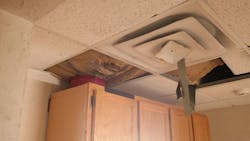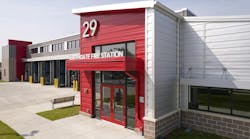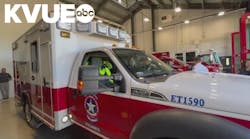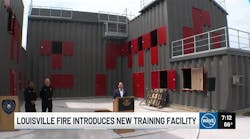Firefighters at Fort Bragg’s Fire Station No. 7 have been complaining for years that their building is deplorable — even sickening.
The roof leaks. Exhaust from the engine trucks wafts into sleeping quarters. Carpets are soaked with water when it rains. Holes in walls are covered by steel sheets.
The problems have been documented by building inspectors, federal occupational safety regulators and Fort Bragg leaders since at least 2014, yet the building continues to fall into disrepair.
Fort Bragg’s leaders acknowledge the problems, but say there’s not enough money for repairs. Firefighters say they’ve gone through the proper channels to lodge complaints they feel pose health and safety risks, but feel ignored.
“When it’s literally raining inside as much as it’s raining outside, to me, it’s just unacceptable,'' said Donny Janik, a firefighter who’s worked at the station for five years. “We need a new fire station,” Janik said. “We don’t need Band-Aids.”
Janik spoke out because he is leaving the fire station soon to take a job out of state. Several of his colleagues wouldn’t speak out for fear of reprisal.
All of the firefighters at the station are civilians.
Fire Station No. 7 plays a critical role on Fort Bragg in supporting deployments and the Global Response Force since it's responsible for aircraft crash response and rescue operations. Aircraft can not take off or land at Pope Field if a crash response isn’t available, which has traditionally been Fire Station No. 7.
In 1994, the fire station was the first to respond to a fiery crash above Pope Airfield, where an F-16 collided with a C-141, engulfing hundreds of paratroopers waiting for an airborne operation. Twenty-four 82nd Airborne Division soldiers died and more than 170 others were injured.
At the time, the fire station was under control of the Air Force.
The 20,000-square-foot fire station was constructed on Pope Field around 1956 and has undergone numerous renovations and additions, many of which were self-help projects by the firefighters.
Michael Griddine, another firefighter at the station, has called on Congressman Richard Hudson to intervene.
In a letter he sent to Hudson in January, Griddine questioned how Fort Bragg’s fire department was able to fund construction of two new stations while No. 7 falls into disrepair.
“Some of the problems with the station involve visible areas of what appears to be mold, rodent and pest problems, multiple roof leaks throughout the facility, carpets with mildew smell and suspected structural issues,” he wrote. “We are seeking answers concerning the whereabouts of the funds that were set aside to construct a new fire station. We are also requesting a complete hazard/suitability assessment of the facility to include the structural integrity by a qualified, third-party contractor not affiliated in any way with the Army or the Fort Bragg installation.”
Hudson said he has contacted the Army to investigate conditions at the fire station.
“The working conditions described to me are unacceptable,” Hudson said. “I will work with the Army to find a long-term solution to this issue.”
Problems cited by firefighters, inspectors and documented assessments include:
• Water leaks from the roof
• Mold under the kitchen sink and in bunk rooms
• Out of compliance fire alarm system that lacks sprinklers, horns and strobes
• Cracks in high bay floors
• Failed sewer system
• Deteriorated roof that ponds water in several places
• Asbestos present
The Air Force was responsible for the building until September 2010, when the Army took it over as part of the Base Realignment and Closure. At that time, officials said the Air Force recommended the building for replacement.
When the Army took control of the building in 2010, officials said they knew there were issues that had to be addressed immediately.
“The first thing we did, the sewer failed,” said Fort Bragg Fire Chief Mark Melvin. “We literally did that the day we walked in.”
Since then, hundreds of work orders have been filed for repairs. Last year, 143 work orders were filed for issues with electrical, heating and cooling, plumbing, locks, exterior utilities and pest control, according to records from Fort Bragg’s Directorate of Public Works, which performs repairs.
In the past six months, two complaints about the fire station’s condition have been lodged with the U.S. Occupational Safety and Health Administration.
Because the firefighters are required to be at the station for 72 hours a week — on three, 24-hour shifts — the building includes a kitchen and private bunk rooms.
The problems in those rooms include apparent mold and their small size.
In March, firefighters said a contractor removed mold from under the kitchen sink and replaced cabinets.
And the bunk rooms are so small that Melvin has said jail cells are larger.
“This is our second home,” Melvin said. “It’s hard for me as fire chief. I want them to have that quality of life. We’ve put a lot of money in this building.”
The fire station, like all buildings on Fort Bragg, receives money for repairs through the Sustainment, Restoration and Modernization fund awarded through Installation Management Command.
Officials at Installation Management Command review repair projects at 75 installations across the globe and award money based on priority. There are currently 254 items on the priority list, totaling $1.3 billion.
Fort Bragg’s Fire Station No. 7 ranks 80th on the list.
“Fort Bragg has special challenges because of the size and number of facilities to keep up,” according to Bill Costlow, spokesman for Installation Management Command.
Costlow said the fire station is an aging building, but there are no health, life or safety issues. He said the small living spaces in the building were acceptable when it was constructed, but standards have since changed.
“The current state of Army funding requires commanders to make tough decisions,” he said. “Addressing the urgent infrastructure challenges brought on by a decade of underinvestment is IMCOM’s first priority. We are working with the Army staff to request additional funds, and also looking for opportunities to close unnecessary facilities in order to reprogram funds to better support soldiers and readiness.”
Last year, Fort Bragg received $106.9 million in restoration funding. Costlow said Fort Bragg is expected to receive about $109 million in fiscal 2017.
But it’s not enough.
Renovation projects at Fort Bragg would cost about $312 million to complete, according to Col. Brett Funck, who took command of Fort Bragg garrison in July 2015.
Funck said he is challenged with distributing restoration funds to more than 8,800 projects — including Fire Station No. 7 — on Fort Bragg. The fire station is currently budgeted to receive $60,000 annually for repairs, but in each of the last three years, has received about $400,000.
“We have taken this seriously,” Funck said, from a conference room in the fire station. “We have communicated this at all levels. I know the Army understands this and they see it.”
Fort Bragg officials have tried three times to attach the fire station to a larger renovation project that would surpass restoration funding and instead require congressional approval. Each time — in 2005, 2012 and 2014/2015 — the projects failed to make the list for Congress to vote on.
Last year, officials from Fort Bragg’s Directorate of Public Works solicited bids for renovations in the fire station. The renovation project would have been to strip, gut and rebuild with the same load-bearing walls.
But the bids came back higher than the allotted budget, so the project was shut down.
This year, however, the building’s roof is slated to be replaced. The Directorate of Public Works said a contract for a new roof should be executed by the end of the year.
The condition of the roof was so poor in 2014 that inspectors recommended a replacement. Several areas of the roof were patched up and in one area, silicone caulk was used for repair.
“Based upon our visual observations and the condition of the roof assembly, the roof should be schedule for replacement in the very near future,” according to a report from engineers that was ordered by DPW.
They estimated the cost to replace the roof was about $500,000, according to the report.
Engineers also said the building is structurally sound, but there are several spaces that didn’t meet federal standards.
“The building has been modified over the years through numerous self-help projects, additions and renovations resulting in spaces that are not in compliance with the International Building Code and Americans with Disabilities Act,” according to the 2014 report.
Among significant issues with the building, the report notes the presence of asbestos, recurrent problems with pests in the defunct Observation Tower and no sprinkler system for fire protection.
Jay Steele, president of Fort Bragg’s American Federation of Government Employees union, said he’s reached out to post leaders for help to repair the fire station. He said he is dissatisfied that leaders are delaying repairs.
“It’s incredibly offensive for someone to tell me, ‘We’ll leave them here and figure out the most inexpensive way to fix this,’” he said.
The safety and well-being of Fort Bragg’s firefighters are in the interest of everyone on post, Steele said.
“When the call comes, everyone on post counts on these guys to be there and be healthy,” he said. “It doesn’t make any sense to me. It’s a unique mission. It impacts everyone on this installation. It’s not getting addressed, and it’s not good enough.”
Staff writer Amanda Dolasinski can be reached at [email protected] or 486-3528.
———
©2017 The Fayetteville Observer (Fayetteville, N.C.)
Visit The Fayetteville Observer (Fayetteville, N.C.) at www.fayobserver.com
Distributed by Tribune Content Agency, LLC.






